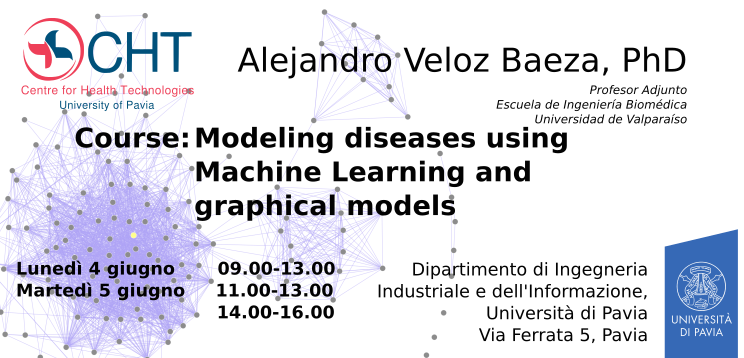Title:
Modeling diseases using Machine Learning techniques and graphical models
Seminar language:
English
Speaker:
Alejandro Veloz Baeza
Dr.(c), Mg. en Ingeniería Informática
Profesor Adjunto
Escuela de Ingeniería Biomédica
Universidad de Valparaíso
Course Contents Registration
Computer Room C1, Department of Electrical Computer and Biomedical Engineering
Monday 04/06 from 09.00 to 13.00
Tuesday 05/06 from 11.00 to 13.00 and from 14.00 to 16.00
Course Description:
Course description
Many health related problems are difficult to identify. One reason for this difficulty is the multidimensionality of diseases that prevents a simple characterization of the underlying physiological phenomena. Also, physicians typically have a very in-depth knowledge in their area of specialty, but many times it is difficult for them to diagnose complex diseases that crosses the classic discipline boundaries. Often, this situation precludes an accurate and timely diagnose.
This lecture focuses in showing current computational intelligence methods, with an special emphasis in graphical models, that can help:
• to make inferences in complex diagnosis scenarios,
• to group diseases and phenotypes to understand relationships among medical specialties, and
• to explore examples in supporting the diagnosis of rare diseases.
Class format
Each class is three hours in length. The course is designed as a lecture-laboratory, with guided in-
class exercises to illustrate topics covered in the lecture, as they are covered. We will also discuss
one paper each day, that illustrates the use of an agent-based model in a biomedical domain.
Course Content:
Content of the teaching programme:
1. Introduction to graphical models in healthcare (1.5 hrs.)
– Health information systems and secondary uses of clinical data (0.5 hrs.)
– Review of current Data Science and Machine Learning approaches for solving healthcare problems (1 hr.)
2. Graphical models of diseases (6.5 hrs.)
– Introduction of graphical models and their use in healthcare (1 hrs.)
– Available data sources and its processing using Python: OMIM, Orphanet, Pubmed, etc. (1 hr.)
– Conditional independence, Markov networks, Bayesian Networks, Possibilistic networks, inference algorithms, and predictions on graphical models (1 hrs.)
– Modeling diseases and phenotypes relationships using graphical models (1 hrs.)
– Strategies for disease graphical models structure identification and dimensionality reduction: topic models, Natural Language Processing methods, association rule analysis, fuzzy rules, etc. (1 hrs.)
– Computer exercise: Building a graphical model of selected diseases and their phenotypes using Python and Gephi (1.5 hrs.)
